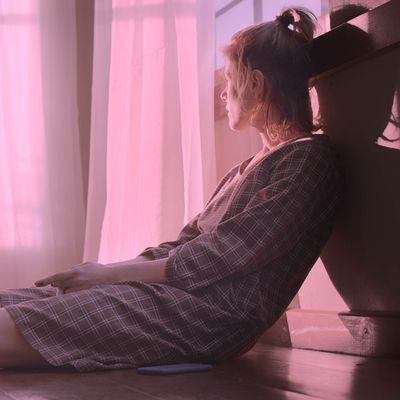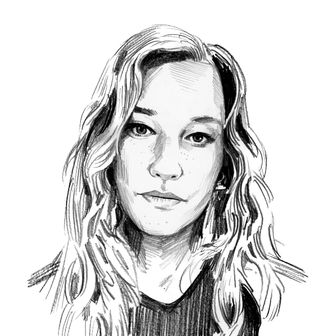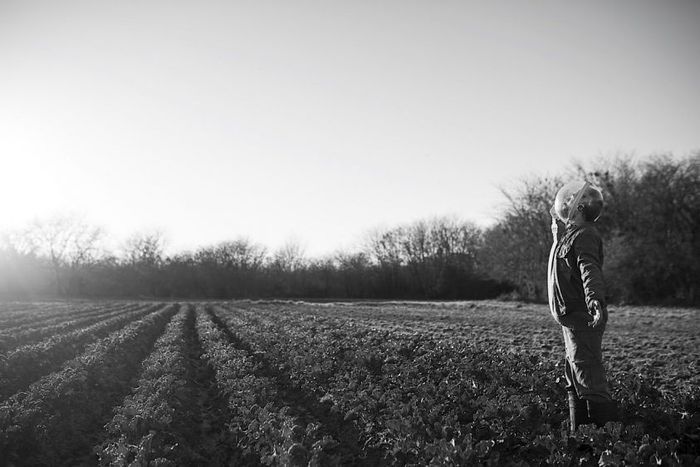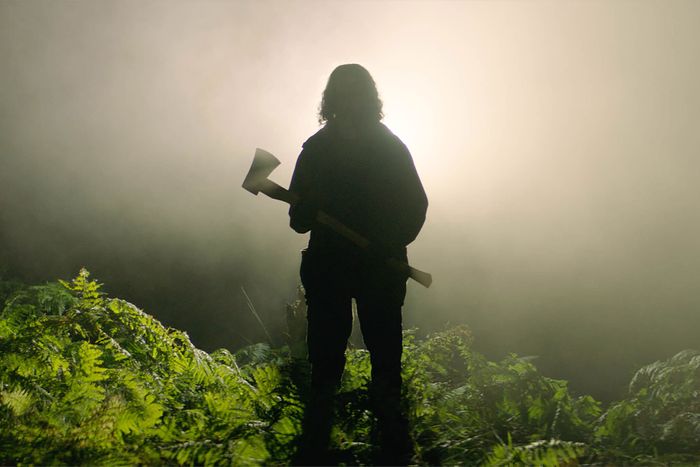
In the upcoming sci-fi indie Little Fish, Olivia Cooke’s new husband, Jack O’Connell, starts to forget stuff, like which day of the week they got married and where his tattoos are. He’s experiencing the symptoms of a new, mysterious virus called Neuroinflammatory Affliction (NIA), an Alzheimer’s-like condition in which people’s memories disappear either instantaneously or in a slow, painful trickle. Nobody knows how NIA is transmitted or why it affects certain people and not others, so nobody really does anything different in their day-to-day life except for occasionally step out of the way when somebody forgets how to drive and crashes into a telephone pole. However, about halfway through the film, when Jack O’Connell agrees to participate in a risky medical trial, he dons a face mask for about five minutes. This otherwise inconsequential bit of plot distracted me for the remainder of the movie. I became fixated on whether or not NIA was airborne or spread via surfaces; if it was not airborne, why was he wearing a mask, and if it was, why was he only wearing a mask for five minutes?
In another world, Little Fish is the kind of movie that would make me turn to my boyfriend, weeping, and insist that we get our addresses inked on the bottoms of our feet in case our personalities are spontaneously deleted. But, in this reality, Little Fish has the questionable luck of being one of several forthcoming indie films that center on some kind of mass pandemic-esque event, employing a viral catastrophe as narrative device at a time when an actual pandemic event is offering us very little metaphorical value. Three out of four were conceived of and filmed pre-pandemic — Little Fish, Pink Cloud, and The Dog That Wouldn’t Be Quiet — while the fourth, Ben Wheatley’s In the Earth, was written and produced in 2020. All save for Little Fish premiered this week during the virtual version of the 2021 Sundance Film Festival. As a result, I mainlined these films while stuck in my own apartment, the very real coronavirus still brewing outside.
My bleakest solo watch party began with The Pink Cloud, a Brazilian sci-fi film directed and written by Iuli Gerbase that begins with the sentence, “This film was written in 2017 and shot in 2019. Any resemblance to actual events is purely coincidental” — as if the story were nervous we were going to sue it. In the film, a cute cloud descends over Earth, killing everyone in its path within ten seconds. The rest of the movie centers entirely on a single couple — Giovana (Renata de Lelis) and Yago (Eduardo Mendonça) — as they grapple with the fact that they’re locked down for a week, a month, a year, then several years, completely unable to leave their homes. They receive food and other necessities via a tube suctioned to their window. Slowly, Yago starts to convince the stubborn and independent Giovana that the two of them should have a child, and engage in a sort of sad mimicry of Normal Family Life. Giovana resists for as long as she can, but, trapped as she is in a permanent state of depressive boredom, she eventually gives in; for the duration of Pink Cloud, Giovana wrestles with the larger freedoms that the cloud has stolen from her and the personal freedoms that she willingly gave up to Yago.
I felt chilled to the bone by certain now-familiar refrains in The Pink Cloud, parroted back to me by fictional characters invented before COVID-19 hit: “I’ve heard it might go away during the winter. Something about the weather, you know? The cold makes the cloud’s condensations dissolve.” “The cloud is the new natural selection.” If I’d seen the film in any other context, I might have focused more on what it had to say about women and reproduction and societal expectations. In the context of today, though, it mostly just served to send me further into a depressive spiral, wondering if I, too, would turn my living room into a nightclub so that I might role play with my estranged partner while our ambivalently conceived child sleeps in the next room. I paused to brush my teeth for four minutes straight while watching the characters on screen give themselves dental cleanings over Zoom. By the end of the film, I’d perked up a bit — at least we were able to go outside! At least our clouds were white and not instantaneously toxic.
Next up was The Dog Who Wouldn’t Be Quiet, a strange little curio from Argentine filmmaker Ana Katz, which was also made pre-pandemic. The first 40 or so minutes follow the simple travails of a man named Seba (Daniel Katz) as he loses his job and his dog in short order, takes on a variety of odd gigs, meets his wife, has a child, and then, suddenly, collapses in a field where he’s working alongside several others. As it turns out, for reasons that are never fully explained, Katz’s world is experiencing a pandemic that only affects people if they breathe air that’s higher than four feet off the ground. Rich people are able to wear helmets, but Seba and his family struggle to afford them. At a doctor’s appointment for their newborn child, the physician tells Seba and his wife that this will likely be the only life their child knows, but that they shouldn’t worry too much about it. “They were born in this world,” he says. Like the relatively happy-go-lucky child in The Pink Cloud, Seba’s baby won’t experience reality any other way. They’ll never feel the paroxysms of sadness their parents do.
Here, the pandemic does pass, again without any explanation; the helmets disappear and nobody seems too scarred. Unlike The Pink Cloud, Katz’s particular piece of Pandemic Art (™) imagines a world where things have settled back to something resembling normalcy, a far cry from my current reality. However, neither cinematic scenario — the pandemic ends, the pandemic never ends — left me feeling more or less hopeful. I could conjure the 2019 version of myself that might’ve enjoyed them, but the 2021 version of me, who has the hair and temper of a cartoon Disney villain, could not find the patience for dreamy, moody movies where an imaginary sickness stood in for something else, where it was desperately mined for meaning.
At this point, I attempted to break up my pandemic-themed, at-home film festival with other Sundance movies, but realized it was nearly impossible to escape the specter of our moment, or more specifically, the fact of our isolation and alienation and general sense of unhinged-ness. Zoe Lister Jones and Daryl Wein’s How It Ends was filmed during our pandemic, and it shows — characters speak outside only, never hugging or even approaching each other, glibly discussing the imminent apocalypse. In Land, a grieving Robin Wright locks herself in a cabin in the woods and sees only one other human being. In John and the Hole, a young boy hurls his immediate family into a hole in the backyard, only to realize how deeply lonely he is without them. On the Count of Three is about two men so alienated from society and themselves that they plan a double-suicide. Two movies — Superior and The Blazing World — centered on a pair of separated twins trying to find their way back to each other. In Knocking, another grieving woman hides away from the world, this time in her own apartment, where she becomes convinced that she’s hearing the sounds of a neighbor being slowly tortured to death. I wondered if every movie ever made had actually been about people being alone and sad and I just hadn’t noticed.
The last pandemic film on my list, Ben Wheatley’s In the Earth, was also made during the pandemic, and revolves around a vaguely similar rampant illness, albeit one that prompts everyone to walk around with PCR and blood and urine tests that they randomly administer to one another. There’s a reference to a third wave, a conversation about how “it’ll be back to normal sooner than you think; everyone will forget what happened.” And then things get genuinely interesting. Our protagonists, a scientist named Martin (Joel Fry) and a park ranger named Alma (Ellora Torchia), venture into the woods together to find another enigmatic scientist named Olivia (Hayley Squires), who’s been working on some sort of cure for the unnamed virus. Instead, they find Zac (Reece Shearsmith), a vengeful alternative-universe QAnon type who imprisons them in his tent and starts implanting things into their arms and chopping off their toes in the interest of sacrificing them to what he believes is the forest’s hive mind. As it turns out, the real horror of In the Earth has nothing to do with the pandemic and everything to do with an Annihilation-like blurring of nature and humanity. As I watched Zac chase Alma with a bow and arrow through the woods, I nearly screamed with relief. How nice, I thought, to watch a deranged killer just be himself, even during a pandemic.
It reminded me of an earlier pandemic watch, Host, a Zoom-horror film about friends holding a seance during the U.K.’s first COVID lockdown. (Host was released months before Songbird, Michael Bay’s Nicholas Sparks–esque QAnon propaganda based on the COVID-19 outbreak, and Doug Liman’s Locked Down, a too-cute period piece about early quarantine, packed with stale jokes about Zoom and wearing roomy pajama pants beneath a structured blazer.) I loved Host, and found it surprisingly and genuinely cathartic: a demon is murdering people, i.e., behaving like it normally would, even during a pandemic. It occurred to me, after watching a series of incredibly self-serious and depressing indie movies, that the only filter through which I wanted to observe a world even remotely similar to our own is maximalist horror. It remains the only genre in which everyone acts as they usually do (scared of being murdered or excited to be doing the murdering), outbreak or not. It’s the only genre truly capable of placing a pandemic in perspective, trading our very real hellscape for a vaguely shittier one. And so it manages (sometimes accidentally) to show us how being alive right now feels — messy, surreal, spooky, sadistic — without situating us in some uncomfortable uncanny valley.
At the end of In the Earth, Olivia explains, to a completely mind-fucked Alma and Martin, what went so wrong with Zac — an explanation that, to me, felt like it applied directly to this new wave of pandemic films, which (understandably) work hard to turn a crushing worldwide tragedy into a narrative device or a metaphor when in reality it’s just chaos all the way down, with no inherent order, no “lesson,” no high-minded allegorical value. “Zac is trying to make meaning where there is none,” says Olivia. “This is a psychological problem with humans. We have to make a story out of everything.”
More From This Series
- In Weirdo Night, the Avant-Garde Fights Dirty
- Virtual Buzz Led to the Biggest Movie Sale in Sundance History
- Here Are Your 2021 Sundance Film Festival Award Winners




